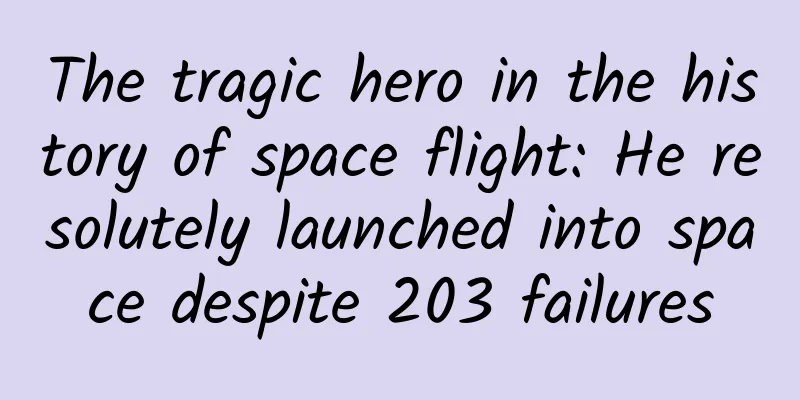The tragic hero in the history of space flight: He resolutely launched into space despite 203 failures

|
In the mid-1960s, the Soviet Union, which had won at the "starting line" in the field of aerospace, gradually felt a crisis: first, the United States, which had been defeated repeatedly, gradually caught up; second, it encountered a bottleneck in technology. After the Voskhod 2 manned spacecraft was launched and returned in 1965, no manned spacecraft was launched until 1967. In fact, during this period, although the Soviets felt superior, they did not dare to sleep well, but instead worked hard to design a new manned spacecraft - the Soyuz. A bad start and suffered three consecutive defeats The idea of the Soyuz manned spacecraft was first proposed by Korolev in 1962. It is composed of a crew module, a propulsion module and a manned spacecraft that can orbit the moon, which coincides with the design of the US Apollo spacecraft. The name "Soyuz" implies unbreakable, and the Soviet Union also had high hopes for the "Soyuz". The Soviet Union's space program at the time was divided into three steps: the first step was to establish a manned space station in orbit for military missions; the second step was to build a manned spacecraft capable of completing the moon landing mission; and the third step was to build a global communications satellite system. Looking back today, more than 50 years later, this plan is undoubtedly great, and all of these ideas were later realized by the United States. With the design and development of the Soyuz, the first group of astronauts was finalized in September 1965. Komarov, who had entered space as the navigator of the Voskhod 1 mission in 1964, joined the group again, and the well-known "Soviet hero" - astronaut Gagarin served as his replacement. Soviet astronaut Vladimir Komarov In January 1966, chief designer Korolev died of illness, and the development of the Soyuz has not been going smoothly. Before launching a manned mission, unmanned testing of the spacecraft is an essential procedure. Previously, the Soyuz had conducted two unmanned tests: one was forced to self-destruct due to loss of control; the other exploded directly on the launch pad, not only destroying the spacecraft but also collapsing the launch tower. The two accidents dealt a huge blow to the Soviet Union, which was at its peak, and faced with the success of the American Gemini program, they were even more anxious. After all, everyone wanted to "hold" the moon in their hands first! After a series of failures, the Soviet State Committee decided to conduct another unmanned test flight before the manned test of the Soyuz. However, the previous explosion caused the No. 31 platform of the Baikonur Cosmodrome, which is the main launch platform of the Soyuz, to be severely damaged and needed to be repaired for 6 months. At that time, if the launch site was to be changed, the fuel filling system and other hardware equipment had to be operated in the No. 31 area. In desperation, the Soviets had to refuel the rocket in the No. 31 area and then transfer it to the No. 2 area. However, misfortunes never come alone. During the transfer process, a locomotive derailed. In order to ensure safety, the entire track had to be inspected... It was not until February 3, 1967 that the third Soyuz unmanned spacecraft was finally placed on the launch pad in the severe cold. On February 6, with only 4 hours left before the launch, the rocket launch was aborted due to technical reasons. The anxious Soviets were almost collapsed! Because the weather in Baikonur is not always suitable for rocket launches. However, the next day, the engineers of the "fighting nation" still launched the "Soyuz" despite the severe cold of -22 degrees Celsius and strong winds of 80 kilometers per hour. As everyone expected: the flight status was very bad at the beginning, but it finally managed to enter orbit. Although it had to return early due to malfunctions with the boosters and solar arrays, the final landing point was 510 kilometers away from the expected point, and the heat shield of the return capsule was burned through, it finally completed a complete circle according to the procedure. So far, three consecutive unmanned tests of the Soyuz spacecraft have ended in failure. "Disease-infected" launch ship destroyed and people killed A week later, experts met to discuss the test results. Surprisingly, among the group of experts, only one named Prudnikov suggested that unmanned testing should be increased, while most people were speechless because of the "gift to the country": 1967 was the 50th anniversary of the victory of the October Revolution. Perhaps, this really fulfilled the old saying: A thousand people's yes is not as good as one scholar's outspokenness. Unfortunately, the decision makers did not listen to this scholar's outspokenness. And everything that happened afterwards seemed to have been destined at this time! The Soviets were still preparing for the first manned test of the Soyuz as planned, and the astronauts arrived in Baikonur two weeks before the scheduled launch date. According to the plan, Soyuz 1 will be launched first with one person on board, and Soyuz 2 will be launched the next day with two people on board. The two spacecraft will merge and dock in orbit, and the astronauts of Soyuz 1 will enter Soyuz 2, and then the three astronauts will return to the ground on Soyuz 2. This is very similar to the orbit transfer activity of the lunar mission. Despite 203 recorded failures, Soyuz 1 was launched at 3:35 a.m. on April 23, 1967, marking the first manned mission of the Soyuz spacecraft. Although the Soviet Union had launched several manned spacecraft such as Vostok and Voskhod before this, the Soyuz was not only larger in size, but also used completely new technologies. The Soyuz 1 carrying astronaut Komarov successfully launched, but a series of faults occurred after entering orbit: the right solar array failed to unfold, resulting in insufficient power supply to the spacecraft; the shortwave radio transmitter could not work properly; and the attitude control system could not control the spacecraft's attitude well. Komarov in a space suit Komarov tried to steer the spacecraft toward the sun, but failed. He then tried to manually turn the spacecraft using the attitude control thrusters, but failed as well. On the third orbit, Komarov tried to adjust the spacecraft again, and also tried to knock on the outer wall of the spacecraft to shake out the undeployed solar panels, but failed again. On the fifth orbit, Komarov's attempt to use the ion orientation system to correct the attitude failed again. What is scary is that when Soyuz 1 was facing serious problems, the heads of the National Committee still planned to launch Soyuz 2 to complete the docking mission. Of course, the considerations of the National Committee were not completely nonsense: if Soyuz 2 could successfully dock with Soyuz 1, the astronauts on Soyuz 2 could deploy the solar panels of Soyuz 1 through extravehicular activities. But the problem is that this requires Soyuz 2 to carry three astronauts into space, and the return capsule of Soyuz cannot accommodate four people to return to Earth. In the end, the National Committee decided to cancel the launch of Soyuz 2 and terminate the flight mission of Soyuz 1, and the spacecraft returned urgently. When Soyuz 1 flew to the 17th lap, the automatic return failed, and Komarov had to use manual control and returned on the 19th lap. Data showed that Soyuz 1 would land east of Orsk at around 6:24 Moscow time. But when Soyuz 1 returned to an altitude of about 7 kilometers and opened the parachute, the spacecraft lost its attitude, causing the parachute ropes to get tangled together, and the main and auxiliary parachutes failed to open. The return capsule fell to the ground at a speed of 150 kilometers per hour and caught fire. Komarov died, becoming the first astronaut to die while performing a manned space mission. When the rescue team arrived at the landing site, they saw black smoke rising into the sky. The return capsule was on fire, and the melted metal and soil mixed together to burst into dazzling flames. The wreckage of the Soyuz 1 return capsule No one expected that Komarov miraculously overcame all the failures encountered by Soyuz 1 during the flight, but what finally cost him his life was the parachute - the main parachute did not open and the backup parachute also failed. On April 26, 1967, the Soviet Union held a funeral of the highest standards for Komarov, with 150,000 people attending spontaneously. His ashes were transported across Red Square by military vehicles and buried under the red walls of the Kremlin. On April 26, 1967, Komarov's urn was loaded on a military vehicle, and more than 150,000 Soviet citizens saw him off. The Soviet Union gave Komarov a state funeral and placed his ashes under the red wall of the Kremlin. Later, someone recalled that Komarov could have chosen not to participate in the Soyuz 1 mission, in which case it would have been Gagarin who would have sat on the Soyuz 1. At that time, Komarov already knew that the Soyuz 1 had 203 fault reports, and he once said: "If I don't perform this flight mission, they will send a backup astronaut, and Gagarin is my backup. He will take risks for me, and we agreed to take good care of him." However, Komarov did not expect that less than a year after his death, his comrade Gagarin would be killed in a plane crash during a flight training. Komarov (right) and Gagarin (left) together Komarov used technology to overcome a series of problems encountered by the spacecraft during the flight, but ultimately failed to change the fate of being unable to return safely. As a true warrior and hero, Komarov not only belongs to the Soviet Union, but also to all mankind. His name is recorded in the annals of human history, just like the great cause he is engaged in, which is enough for people to look up to! |
Recommend
Li Auto's wholly-owned subsidiary was listed as a "debtor", with a total execution amount of approximately RMB 35.23 million
Recently, Ideal Auto's wholly-owned subsidiar...
Is satisfying needs also death? The life decay cycle and countermeasures of social products!
The Internet has been experiencing a cold winter ...
The reason why the great poet Han Yu burst into tears was...丨Science Museum
Ancient scholars advocated "reading thousand...
Domestic smart watches: groping in the dark
"We have clearly realized that smart watches...
In autumn and winter, we recommend you wear 3 types of clothes and stop wearing 5 types of clothes
We wear clothes every day, but did you know that ...
After school starts, two diseases are prevalent, parents must pay attention →
After the spring semester begins, hand, foot and ...
Apple server abnormalities have caused a sharp drop in the daily activation volume of many apps!
In the past two days, many friends have reported ...
How much does it cost to create a flash sale mini program in Bijie?
There are two types of Bijie flash sale WeChat ap...
Thundergod ZERO 3060 gaming laptop: The performance is like a walking desktop, but the price breaks the industry bottom line
For a long time, gaming laptops have been regarde...
Why are there no affordable ultrabooks?
When Intel announced the new concept of "Ultr...
Lucy mission: exploring the secrets of the solar system's "time capsule", what will the answer be?
"Lucy" is the name given by a group of ...
Is there any possibility for the marginalized second-rate video websites to revive?
Attracting "eyes" does not necessarily ...
How to monetize short videos? Here are 7 ways
In recent years, short videos have been very popu...
The industry's first million-level electric luxury car with the "CATL Inside" logo is about to be launched
Recently, Mengshi Technology and CATL officially ...
This tree is very afraid of being tickled, go and try it!
Crape myrtle is a common garden flower and now th...









